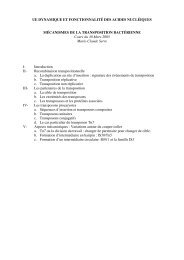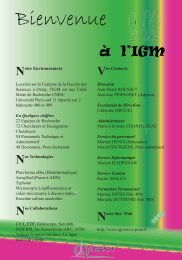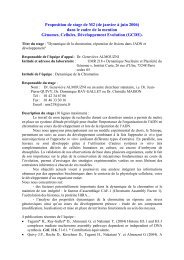Microbiology
Microbiology - Institut de Génétique et Microbiologie
Microbiology - Institut de Génétique et Microbiologie
- No tags were found...
Create successful ePaper yourself
Turn your PDF publications into a flip-book with our unique Google optimized e-Paper software.
Autumn Meeting 6–9 September 2010<br />
↑CONTENTS<br />
University of Nottingham – www.sgmnottingham2010.org.uk<br />
NT03<br />
POSTER ABSTRACTS<br />
Streptococci<br />
NT03<br />
↑CONTENTS<br />
NT03/01 SzeF, SzeN and SzeP: three novel Streptococcus zooepidemicus superantigens<br />
ROMAIN PAILLOT 1 , Alistair Darby 2 , Emma Anderson 1,3 , Nicola Wright 1 , Karen Steward 1 , Katy Webb 1 , Ken Smith 3 , Simon<br />
Priestnall 3 , Sandra Schöeniger 3 , Kerstin Erles 3 , Androulla Efstratiou 4 , Carl Robinson 1 & Andrew Waller 1<br />
1<br />
Dept of Infectious Diseases, Centre for Preventive Medicine, Animal Health Trust, Lanwades Park, Kentford, Newmarket, Suffolk<br />
CB8 7UU; 2 School of Biological Sciences, University of Liverpool, Liverpool; 3 Dept of Pathology & Infectious Diseases, Royal Veterinary<br />
College, Hatfield; 4 Health Protection Agency, London<br />
The horizontal transfer of mobile genetic elements and their associated cargo genes between streptococcal species can significantly alter<br />
the virulence properties of recipient strains. Gain of prophage elements by Streptococcus pyogenes that contain superantigen-encoding<br />
genes has been linked with increased morbidity and mortality in humans. Similarly, the acquisition of φSeq3 (containing seeL, seeM) and<br />
φSeq4 (containing seeH, seeI) by Streptococcus equi have been suggested to represent key steps in the evolution of this host-restricted<br />
equine pathogen from an ancestral Streptococcus zooepidemicus strain. Streptococcus equi subspecies zooepidemicus is the most frequently<br />
isolated opportunistic pathogen of the horse. Streptococcus zooepidemicus also infects a wide range of other animal species including<br />
cattle, sheep, pigs, monkeys and humans.<br />
Culture supernatants from several strains of Streptococcus zooepidemicus possess superantigen activity, but these strains lack known<br />
superantigen-encoding genes. Superantigens are bacterial toxins that trigger unspecific T-cell proliferation and overzealous inflammatory<br />
cytokine production in the host. We sequenced the genome of one of these putative superantigen-producing isolates, S. zooepidemicus<br />
strain BHS5 (SzBHS5). The strain SzBHS5 has been recently associated with several cases of fatal haemorrhagic pneumonia in dogs.<br />
SzBHS5 contains three novel superantigen-encoding genes, szeF, szeN and szeP, the products of which share 59%, 34% and 49% amino<br />
acid sequence identity with SpeH, SpeL and SpeM, respectively.<br />
To determine the prevalence of Streptococcus zooepidemicus sAgs, we screened by quantitative PCR (qPCR) a panel of Streptococcus<br />
equi and Streptococcus zooepidemicus strains that are representative of the wider population as defined by MLST. This included 26<br />
isolates of Streptococcus equi (representing 2 STs) and 165 isolates of S. zooepidemicus (representing 111 STs). Surprisingly, 35% (57 of<br />
165) of Streptococcus zooepidemicus isolates examined contained szeF, 19% (31 of 165) contained szeN and 21% (35 of 165) contained<br />
szeP, with szeN and szeP almost always occurring together. The presence of superantigen-encoding genes was significantly associated<br />
with mitogenic activity in the Streptococcus zooepidemicus population (P








